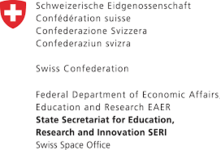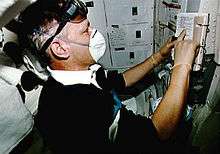Swiss Space Office
The Swiss Space Office (SSO) manages the national space program of Switzerland.[1] The SSO is part of the State Secretariat for Education, Research, and Innovation. The head of the SSO is Renato Krpoun.[2]

Switzerland is a founding member of the European Space Agency, and has actively participated in European space development since 1960. The Swiss Space Office opened in 1998. The role of the SSO expanded to cover all aspects of space policy in 2000, when the new national constitution came into force.[3]
According to Jane's, the SSO is "the administrative unit charged with planning and implementing Swiss space policy", which was defined by the Swiss Federal Council.[4] The SSO office in Bern includes the Federal Commission for Space Affairs (CFAS), and the Interdepartmental Coordination Committee for Space Affairs (IKAR).[1]
Claude Nicollier is a Swiss Astronaut and has been on several missions with the United States space program in the 1990s and is also a member of the European Astronaut Corps. By 2007 he had retired from Swiss space missions to become a professor at EPFL.[5] Switzerland's Marc Bertschi became the head of the ESA launcher program in 2007.[6]

Areas of focus
- Earth Observation
- Space Industry / Technology
- Space Navigation
- Space Science
- Sustainable Space Logistics
- Human Spaceflight, Exploration and Microgravity
- Launchers
- Education Activities
Manned space missions
U.S.-Swiss Space Shuttle missions:
Swiss space technology

Selected examples of Swiss contributions to space exploration and technology.[7]
- Omega Speedmaster, worn by Buzz Aldrin on the moon, and standard equipment for NASA astronauts.
- Solar sail developed at University of Bern used by the Apollo Program to measure solar wind on moon.
- ESA Ariane rocket uses Swiss RUAG Space payload fairings.
- Genesis probe sample return analyzed at Federal Institute of Technology at Zurich.
- NASA Mars Pathfinder rover used Swiss Maxon motors.[8][9]
- University of Neuchatel contributed to the Mars Phoenix (spacecraft).
- University of Bern developed a ultra stable light source for testing NASA's TESS space telescope.
- CHEOPS (CHaracterising ExOPlanets Satellite) space telescope developed at the University of Bern.
- The Colour and Stereo Surface Imaging System (CaSSIS) is a high-resolution, 4.5 m per pixel (15 ft/pixel), colour stereo camera on board ESA's Trace Gas Orbiter developed at the University of Bern.
Offices
Budget
In 2006, Switzerland contributed CHF 140 million ($142 million) or around 3.4% to ESA's budget.[8] In 2005, the Swiss space industry's turnover was CHF 170 million.[8]
See also
References
- "Focus > Research & Innovation > Space > Bodies". State Secretariat for Education, Research and Innovation. Archived from the original on June 16, 2018. Retrieved 2018-07-11.
- "Organization Chart of the Seri". State Secretariat of Education, Research and Innovation. Archived from the original on July 12, 2018.
- Creola, Peter. "Switzerland in Space – a brief history" (PDF). European Space Agency.
- "Swiss Space Office SSO". articles.janes.com. Jane's Information Group.
- "Claude Nicollier nommé professeur ordinaire de technologies spatiales". EPFL. March 28, 2007. Archived from the original on August 4, 2007. Retrieved March 19, 2009.
- Capper, Scott (February 11, 2007). "Swiss takes over as space agency's rocket man". SWI swissinfo.ch. Swiss Broadcasting Corporation.
- "Swiss in space". SWI swissinfo.ch. Swiss Broadcasting Corporation. December 6, 2006.
- Miserez, Marc-André (January 19, 2007). "Swiss technology travels to outer space". SWI swissinfo.ch. Swiss Broadcasting Corporation.
- Landon, Vincent (February 20, 2002). "Swiss technology powers Mars mission". SWI swissinfo.ch. Swiss Broadcasting Corporation.